Zapier is a powerful and efficient automation tool, which can help you to increase productivity. Zapier can connect apps, automate workflows, and much more. These Zapier alternatives offer many of the same features offered by Zapier but at a cheaper cost, so you should give them a chance.
With its versatility and the impressive number of integrated apps, Zapier is undoubtedly one of the best automation software tools.
However, it’s not perfect (after all, nothing is), and Zapier can quickly become very expensive. There are alternative task automation products out there that might be a better fit for your needs.
Let’s dive into some of the best paid and free Zapier alternatives on the market in 2025.
TL;DR: Top 3 Zapier Alternatives
- Pabbly Connect (best all-around solution with a cheap lifetime plan – connects 1000s of apps and supports all the popular apps for CRM, Marketing, E-Commerce, Helpdesk, Payments, Web forms, Collaboration and much more)
- Make (best for user-friendliness – integrate 1000s of apps in a no-code visual platform to connect apps, design workflows & build processes)
- IFTTT (best free Zapier competitor – automation platform that joins smart home devices, social media, delivery apps, and much more)
Top Alternatives to Zapier in 2025
Zapier is one of the most popular workflow automation tools on the market. However, it’s not the only option available. Here are some of the best alternatives to Zapier right now:
1. Pabbly Connect
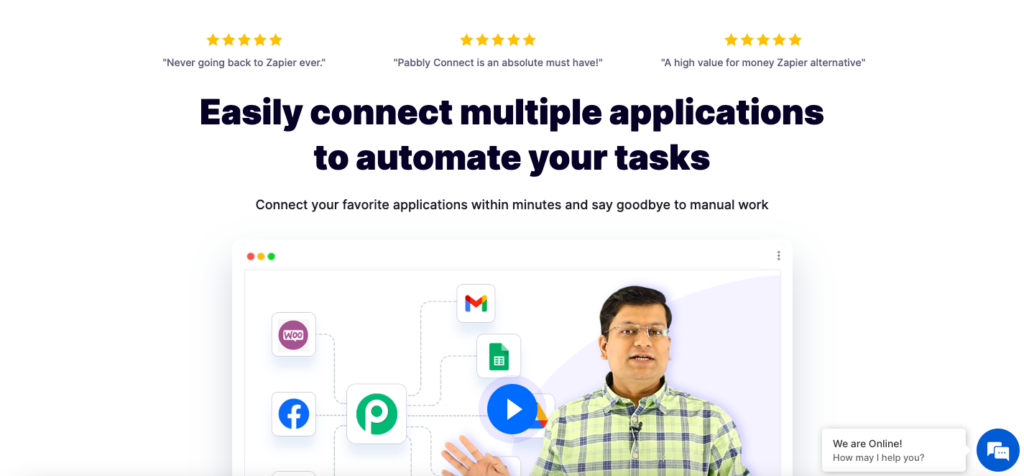
Pabbly Connect is similar to Zapier in many ways, but there are a few important differences between these two task automation tools that earn Pabbly Connect a spot at number one on my list of Zapier alternatives.
Pabbly Connect Features
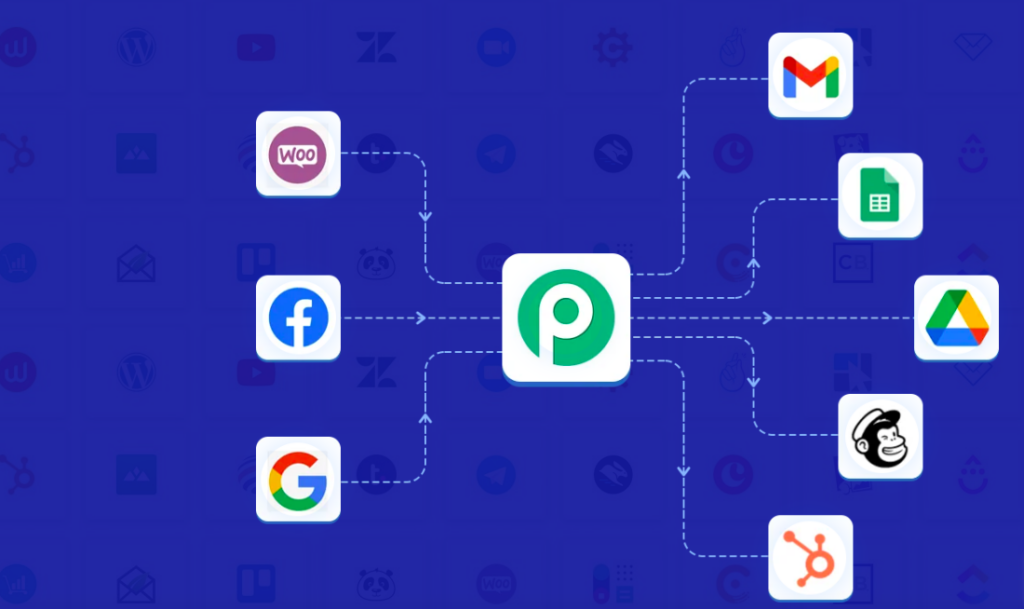
When it comes to automating your workflow, Pabbly Connect is a great all-around solution. So what exactly is there to love about Pabbly Connect?
- Pabbly Connect employs if/then logic to automate complex sequences of tasks in response to different inputs and triggers.
- Integrated with over 1000 apps, including Google Suite, PayPal, Mailchimp, Facebook, WordPress, and WooCommerce.
- It’s super user-friendly. No coding or programming experience required!
- Great value for your money. Pabbly Connect’s unmatched lifetime deal lets you use their automation tools forever, with no limits or restrictions, for one flat payment. This is about as good as it gets when it comes to getting a deal for your money.
All of Pabbly Connect’s plans come with a slew of unique features, including Instant Webhook (a tool to send event-specific responses from one app to another instantly), delaying and scheduling, folder management, multi-step tasks, and more.
Here is an example of a workflow I have created in Pabbly Connect.
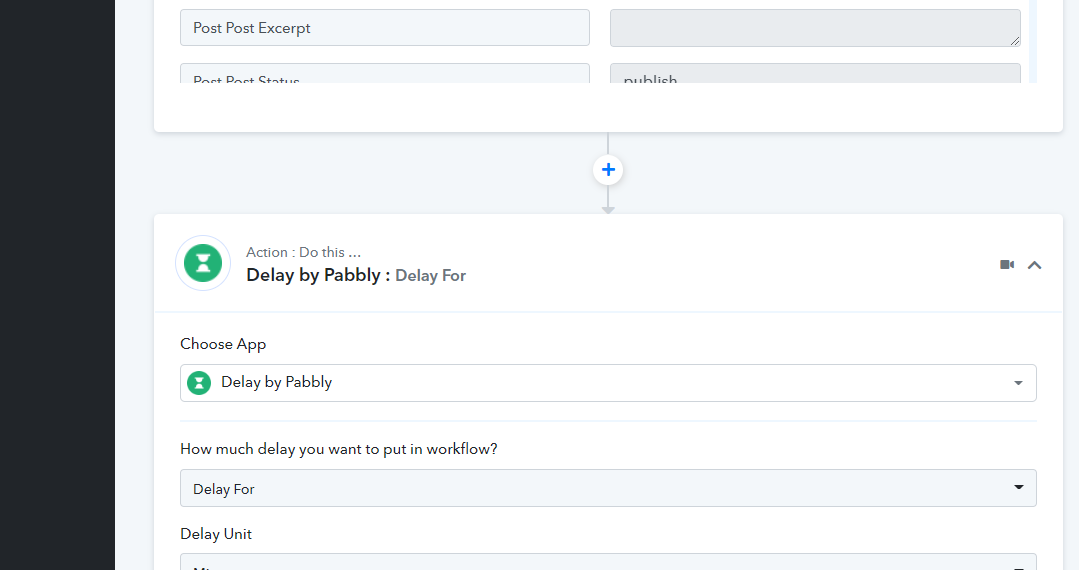
This workflow creates a Facebook page post whenever a WordPress post is updated, it does the following:
When THIS happens: a WordPress post is updated [is the TRIGGER]
THEN do this: create a 2-minute delay [is an ACTION]
and THEN do this: create a Facebook page post (using WP title – WP permalink – WP excerpt) [is another ACTION]
Pabbly Connect Pricing
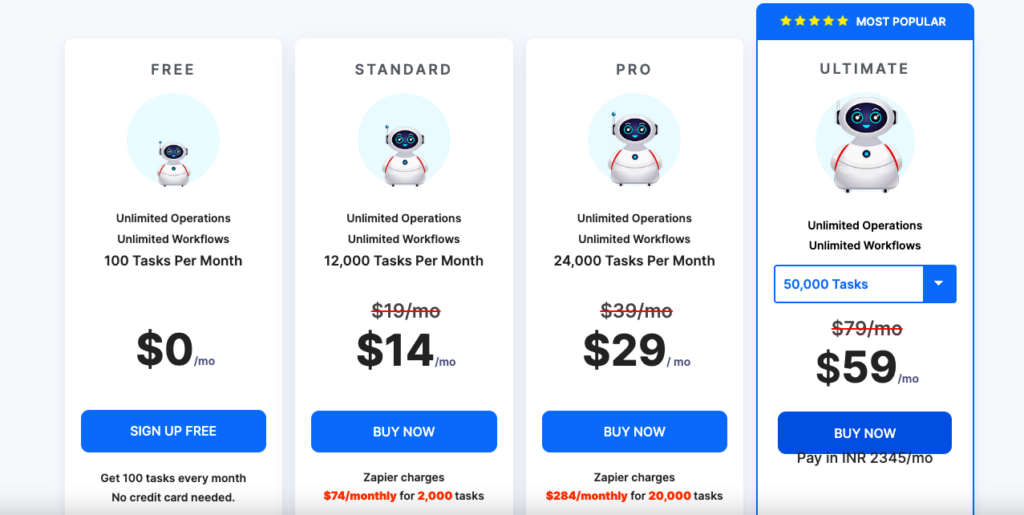
Pabbly Connect offers four feature-packed plans at slightly better prices than Zapier.
- Free ($0/month): Pabbly Connect’s forever free plan comes with unlimited workflows, unlimited automations, 100 tasks per month, unlimited operations, Instant Webhook, Iterator, an email parser feature, and more.
- Standard ($14/month): The Standard plan comes with all the Free plan features plus 12,000 tasks per month.
- Pro ($29/month): The Pro plan comes with all features plus 24,000 tasks per month.
- Ultimate ($59/month): Pabbly Connect’s largest plan comes with all features and starts at 50,000 tasks per month, with the opportunity to go up to a whopping 3,200,000 tasks per month (which raises the price to a sizable $3,838/month).
Best of all, Pabbly Connect doesn’t restrict any features on its plans. What this means is that you get full access to all of Pabbly Connects tools and features with every plan (even the Free plan) – the only thing that changes is the number of tasks you can automate per month.
In addition to its forever free plan, Pabbly Connect also offers a generous, 30-day money-back guarantee if you’re unsatisfied with their product.
Zapier vs. Pabbly Connect?
With its sophisticated task automation capabilities and user-friendly interface, Pabbly Connect is the all-around best Zapier alternative.
It’s safe to say that Pabbly Connect has Zapier beat in terms of value for money, thanks to its generous one-payment lifetime deal.
However, it should be noted that Zapier boasts far more integrations than Pabbly Connect. That said, since Pabbly Connect is integrated with the most commonly used apps and sites, this likely won’t be a problem for most businesses.
If you want to know more about how these two great tools stack up against each other, check out my comprehensive Zapier vs Pabbly Connect comparison.
2. Make (Formerly Integromat)
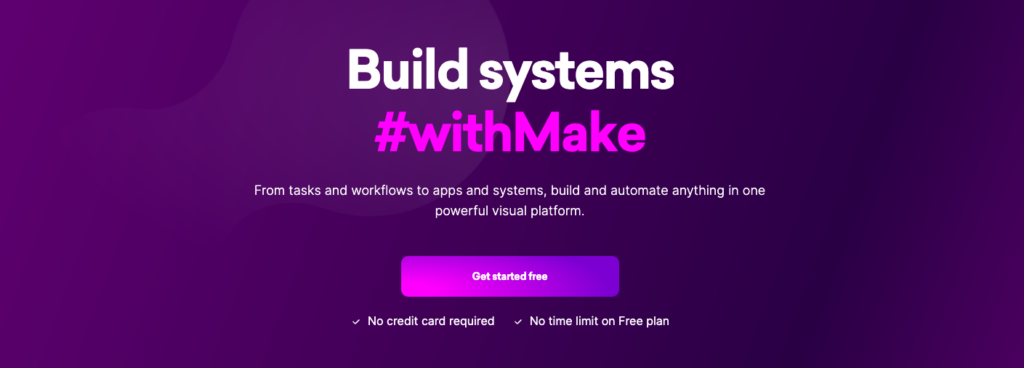
Make.com, formerly known as Integromat, the company underwent a sleek rebranding in 2022 and emerged as Make: a powerful tool for building and automating tasks, workflows, systems, and more.
Make Features
Although Make has too much to offer to include all of it here, some of its most notable features include:
- A stylish drag-and-drop interface. Make uses a highly intuitive, mind map-style interface that makes connecting apps and automating tasks as easy as a few clicks – and genuinely fun!
- Create scenarios to run instantly or schedule them. You can also set a scenario to run in response to a particular event or trigger.
- Integrations with over 1000 apps, including all Google Workspace tools, Microsoft Office Suite, Shopify, Slack, Discord, and Twitter.
In addition to integrations with popular apps, Make also enables you to connect to any public API using their proprietary HTTP app.
Make Pricing

Make offers five plans: Free, Core, Pro, Teams, and Enterprise.
- Free ($0): Includes 1,000 operations per month, Make’s no-code workflow builder, 1000+ app integrations, custom apps, unlimited users, two-factor authentication, real-time execution monitoring, and more.
- Core ($9/month): Comes with all the Free plan features plus 10,000 operations per month, an unlimited number of active scenarios, access to 300+ Make API endpoints, and more.
- Pro ($16/month): Comes with all features plus a full-text execution log search, operations usage flexibility, custom variables, and priority scenario execution.
- Teams ($29/month): Includes all features plus high-priority scenario execution, teams and team roles, and the ability to create and share scenario templates.
- Enterprise (price is given as a custom quote): Make’s most comprehensive plan includes all features plus high-priority customer support, a dedicated customer success manager, tighter security features, and more.
All plans can be canceled at any time, and your account will only be billed through the end of the month (during which time you’ll still have access to your account).
Zapier vs. Make?
Although Zapier and Make are both task automation tools, they are different in a few crucial ways, and each has its own pros and cons.
Make has a far more intuitive and user-friendly interface and is likely a better choice for anyone looking to get started with task automation without a sharp learning curve. Make is also by far the cheaper option – yet another reason why it may be more appealing to beginners.
Although Make offers an all-around better user experience, Zapier is a more versatile tool and comes with more app integrations, making it a better option for anyone looking to automate more sophisticated or complex sequences and tasks.
3. IFTTT

First launched all the way back in 2011, IFTTT has built a reputation over the years as a solid, robust automation software tool.
IFTTT Features
From its incredible prices to its range of features, IFTTT is an automation tool that’s clearly designed with individual users’ needs in mind.
Notable features include:
- Awesome smart home and social media integrations.
- Ability to create multi-step tasks (called “applets”) in response to a single trigger.
- A sweet “forever free” plan with no strings attached or credit card required.
- The ability to design applets yourself or use pre-designed ones.
- Smooth, glitch-free execution of all applets and actions.
Although IFTTT definitely doesn’t come with the most sophisticated range of features, it does exactly what it’s designed to do: help save you time and effort by smoothly automating tasks across the apps and programs you use every day.
IFTTT Pricing
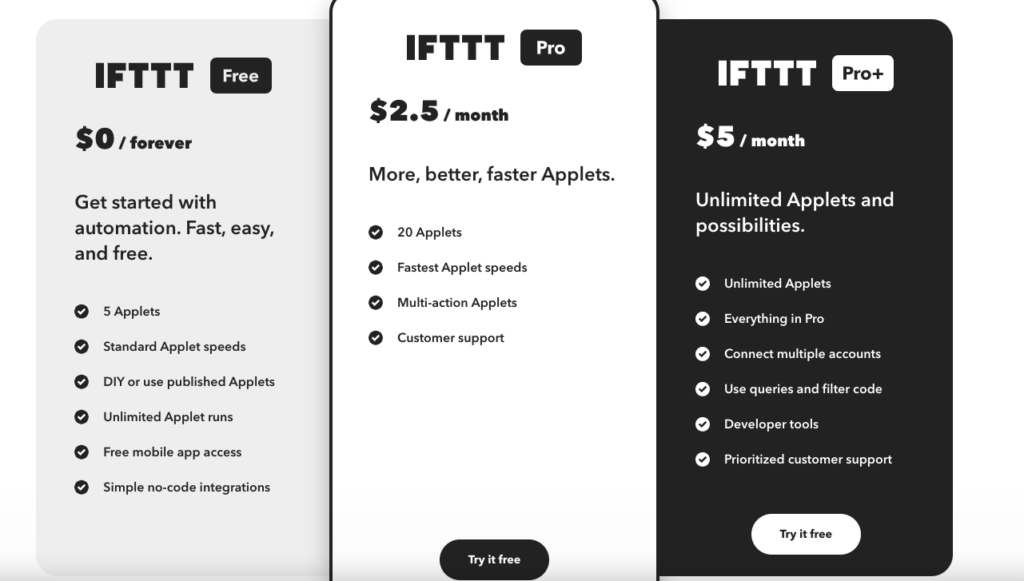
Unlike many of the options on my list, IFTTT has a very simple pricing structure: three plans, three prices.
- Free ($0/month): The forever free plan comes with 5 applets (5 task automations per month), unlimited applet runs, standard applet speeds, DIY and/or published applets, and free mobile app access.
- Pro ($2.50/month): Comes with 20 applets, the fastest applet speeds, the ability to build multi-action applets, and customer support.
- Pro+ ($5/month): For only $5, you get unlimited applets, the ability to connect multiple accounts, use queries and filter codes, developer tools, and prioritized customer support.
In addition to the forever free plan, IFTTT also offers free trials of the Pro and Pro+ plans.
Zapier vs. IFTTT?
Although Zapier and IFTTT are comparable in many ways, there are a few important differences.
Zapier has a larger number of app integrations, with a specific focus on business apps. IFTTT has fewer integrations overall but is integrated with the most commonly used, everyday apps.
Additionally, IFTTT is more hands-on in its guidance and directions, making it arguably a more user-friendly tool.
As such, while Zapier is more designed for companies or teams, IFTTT is likely to be a better fit for individual or personal use.
4. Tray.io

Tray.io markets itself as “the API integration and automation platform for citizen automators.” But what does that mean exactly, and who is Tray.io a good fit for?
Tray.io Features
Tray.io is a sophisticated, cloud-based data integration platform. Like Zapier, it’s designed to help businesses automate daily web tasks and services.
Tray.io is clearly a tool designed with mid to large-scale businesses in mind, as its sophistication (and price) are beyond what’s necessary for most small businesses or individuals.
Popular features include:
- The ability to build complex, multi-step tasks integrated across a wide range of apps and platforms.
- More than 4,500 integrations.
- A simple, drag-and-drop tool for integrating different apps with Connectors (code-free access to any integrated app).
- API (application programming interface) construction and management.
- 24/7 live representative support
Tray.io comes with plenty of pre-built connectors that make setting up your integrations easy. With that said, if you need to build your own connector, the process is a bit more complicated than with many of the other options on my list – including Zapier.
Tray.io Pricing

In addition to the relative sophistication and complexity of its software, Tray.io’s pricing structure should make it extra clear that it’s designed for businesses in need of some serious integration tools.
It offers three plans – Professional, Team, and Enterprise – with workflows priced by volume.
Although the starting prices are no longer listed on their website, based on previous price quotes, you can expect to pay a minimum of $500/month for the Professional plan, with prices increasing from there.
Tray.io offers a free trial but no free plan.
Zapier vs. Tray.io?
Zapier and Tray.io are comparable integration tools in some ways, such as the ability to use these tools with pre-built workflows or design your own.
However, Zapier is clearly designed for small- to mid-sized businesses or individuals, whereas Tray.io has large clients (with even larger budgets) in mind.
If you need a seriously versatile task automation software to help you streamline your business – and if cost isn’t an issue – then Tray.io is a great option for you.
5. Integrately

Founded in India in 2020, Integrately is an ambitious newcomer that has quickly become a solid competitor to the more veteran Zapier.
Integrately Features
Integrately’s founder Abhishek Agrawal markets his product as the best Zapier alternative “for non-techies,” and the company does indeed try to make task automation as simple and streamlined as possible.
Some of Integrately’s best features are:
- 1-click integrations feature makes setting up workflows nearly instant.
- Integrately offers more than 8 million pre-built automations across 900+ apps.
- Integrated with the most commonly used business and personal apps.
- Absolutely no coding required.
Integrately isn’t the flashiest or most sophisticated option on my list, but it’s a workhorse tool that gets the job done at a reasonable price.
Integrately Pricing
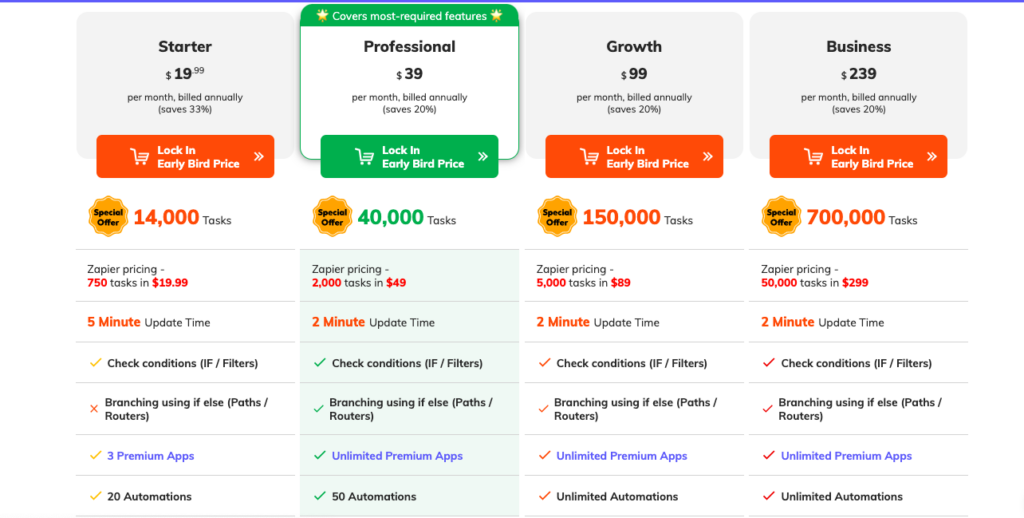
Integrately offers four plans with fairly simple pricing and the option to pay either annually or monthly.
- Starter ($19.99/month): Comes with 14,000 tasks, 5-minute update time, 20 automations, 3 premium apps, premium support, 1 user seat, and more.
- Professional ($39/month): Includes all the Starter features plus 40,000 tasks, 2-minute update time, 50 automations, unlimited premium apps, Iterator, and AutoRetry.
- Growth ($99/month): Comes with all Professional features plus 150,000 tasks, unlimited automations, unlimited users, and folder permissions.
- Business ($239/month): Includes all features plus 700,000 tasks.
Zapier vs. Integrately?
Clearly aware of who the competition is, Integrately works hard to show why it’s a better deal than Zapier: on the site’s Pricing page, you can see a clearly displayed comparison of how many tasks you get for your money with Zapier vs. with Integrately.
After all, value for money is the strongest advantage that Integrately has over Zapier, since the latter has more integrations and is overall a more flexible tool.
When it comes to ease of use, Zapier and Integrately are pretty comparable, although Integrately’s unique 1-click integration builder might arguably give it a slight edge.
6. Microsoft Power Automate

While most of the Zapier alternatives I’ve listed so far started out as scrappy startups and side hustles, Microsoft Power Automate is – you guessed it – the tech powerhouse Microsoft’s entry into the automation software competition.
Microsoft Power Automate Features
Like many of the other Zapier alternatives on my list, Microsoft emphasizes its automation software’s ability to save you time at work and let you get back to focusing on what matters.
Microsoft is nothing if not a veteran software development company, and Power Automate boats a number of great features, including:
- Digital, robotic, and business automation capabilities.
- Fully comprehensive customer support (24/7 live rep phone, email, live chat, knowledge base – they’ve got it all).
- Database integrations and AI tools
- Seamless integration with Microsoft Office Suite, making it a great fit for businesses.
Microsoft Power Automate comes with a fairly advanced range of features if you need them, but it also allows you to keep things simple and straightforward if you just want to automate tasks across a few common apps.
Microsoft Power Automate Pricing
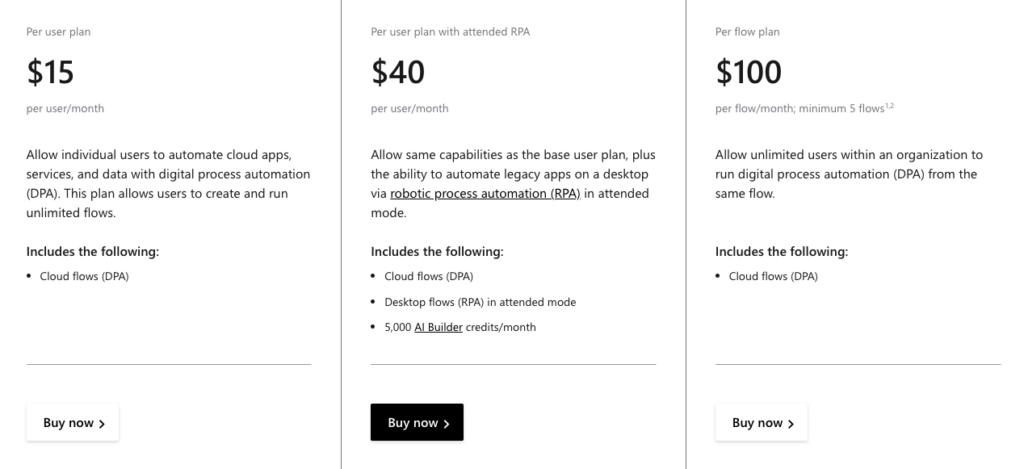
Microsoft’s pricing plans are a little confusing, as the company allows you to either choose from three unnamed plans and pay for a license by the user or by flow run.
- Per user plan ($15 per user/month): Lets users create unlimited flows and automate cloud apps, services, and data with digital process automation.
- Per user plan with attendant RPA ($40 per user/month): Comes with the same capabilities plus the ability to automate legacy apps on a desktop with RPA (robotic process automation). Includes cloud flows (DPA) and desktop flows (RPA).
- Per flow plan ($100 per user/month): Allows unlimited users to run DPA from the same flow.
If you choose to pay per flow run instead, Microsoft offers three options: $0.60 for each cloud flow (DPA) run, $0.60 for each desktop flow (RPA) run in attended mode, and $3 for each desktop flow (RPA) in unattended mode.
Unfortunately, Microsoft does not offer a free trial or a money-back guarantee at this point.
Zapier vs. Microsoft Power Automate?
Ultimately, these two products are pretty similar in terms of features and ease of use.
Whether you choose Zapier or Microsoft Power Automate will depend mostly on what you intend to use your automation software for. If you’re an individual or a business looking for flexibility without sacrificing too much on simplicity, Zapier will likely fit your needs.
On the other hand, if you’re a business looking to automate tasks in a way that integrates smoothly with the software tools you already use (hey, who isn’t using Microsoft Suite at work?), then Microsoft Power Automate is a great option.
7. Workato

Yes, Workato does sound like a combination of “work” and “potato.” But aside from the slightly silly name, Workato is a seriously powerful task automation tool with a lot to offer for enterprise clients.
Workato Features
Workato is trusted by an impressive array of businesses and brands, including large corporations such as HP, Kaiser Permanente, and Adobe.
This should give you an idea of the kind of client that Workato’s product is designed for mid to large-sized businesses looking for complex, end-to-end automation capabilities.
With Workato, you can:
- Automate complex, multi-step tasks based on a variety of triggers
- Community-built integration workflows
- Get cloud-based and on-premises deployment
- Get highly personalized support in the form of in-person and live online training, as well as troubleshooting via live chat, email and phone support.
- A mix of API and UI-based automation
- Workbot platform (designed for developers to build bots with specific applications, particularly for use as conversational interfaces for business processes.)
As an added bonus, Workato also boasts that its automations require 50% fewer operational resources to run and maintain (in comparison with traditional RPA solutions like Zapier).
Workato Pricing
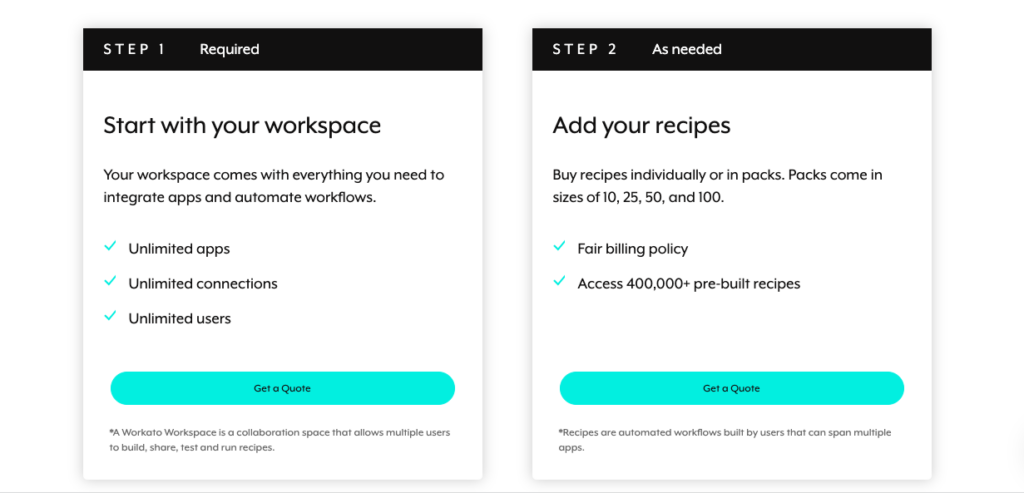
Workato is annoyingly opaque about its pricing, requiring customers to contact them for a custom quote.
With that said, annual pricing for Workato is reported to generally range between $15,000 and $50,000 – yikes!
Zapier vs. Workato?
It should be clear at this point that the primary difference between Workato and Zapier is who these products are intended for.
If you’re an individual or a small-sized business, Workato’s task automation software is both beyond your price range and unnecessary for your purposes.
On the other hand, if you’re a large business or enterprise client with a sizeable budget, Workato’s impressive range of flexible task automation tools might be just the thing you’re looking for.
8. Zoho Flow
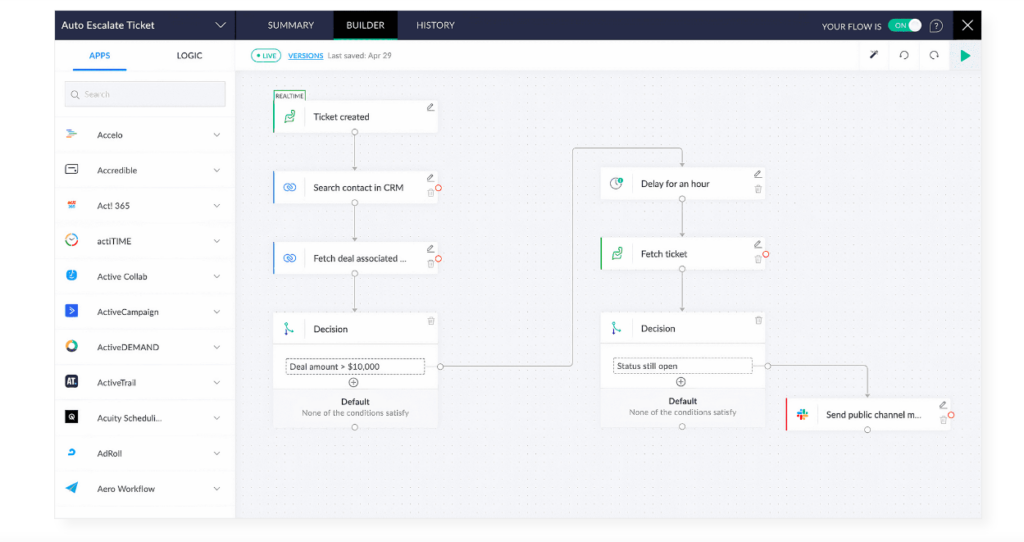
Coming in at number 9 on my list of Zapier alternatives is Zoho Flow, a task automation tool created by Indian tech startup Zoho in 2018.
Zoho Flow Features
Some notable Zoho features include:
- GUI (graphical user interface) drag-and-drop workflow builder tool
- Flow history monitoring
- The ability to use set times or specific events as triggers
- The ability to add your own variations to pre-built workflows
- Deluge (Zoho’s scripting language) can be used to create and add advanced decision trees to workflows.
- A helpful dashboard that displays all your data, processes, and metrics in one place.
- Collaboration features for teammates, including the ability to add members to your account.
Zoho Flow Pricing
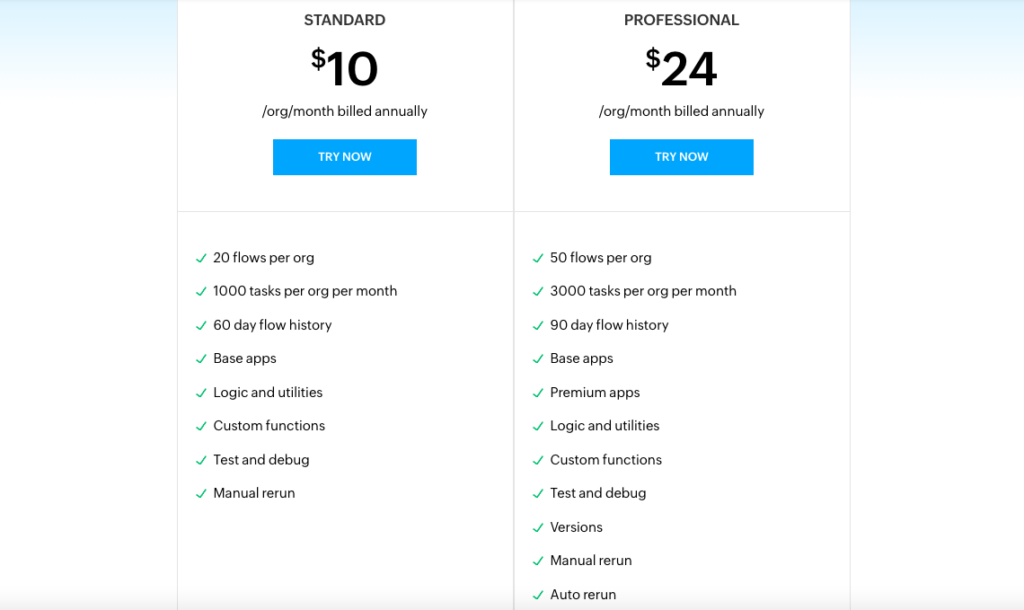
Simplicity is the name of the game when it comes to Zoho Flow’s pricing structure, which comes in two simple plans.
- Standard ($10/month): Comes with 20 flows per org, 1000 tasks per org/month, 60-day flow history, base apps, logic and utilities, custom functions, testing and debugging, and manual rerun.
- Professional ($24/month): Comes with 50 flows per org, 3,000 tasks per org/month, 90-day flow history, premium apps, versions, manual rerun, and auto rerun.
It’s free to sign up (no credit card required), and you get a generous 15-day free trial to test Zoho Flow out and see if it’s right for you.
Zapier vs. Zoho Flow?
In short, Zoho Flow is a great tool for newcomers to the world of task automation who want a simple yet effective tool.
While Zoho Flow lacks some of the cool features that Zapier offers (such as its email parser tool that scans and pulls data out of incoming emails to trigger events in real-time), it is nevertheless a robust task automation tool that offers great value for your money.
9. Outfunnel
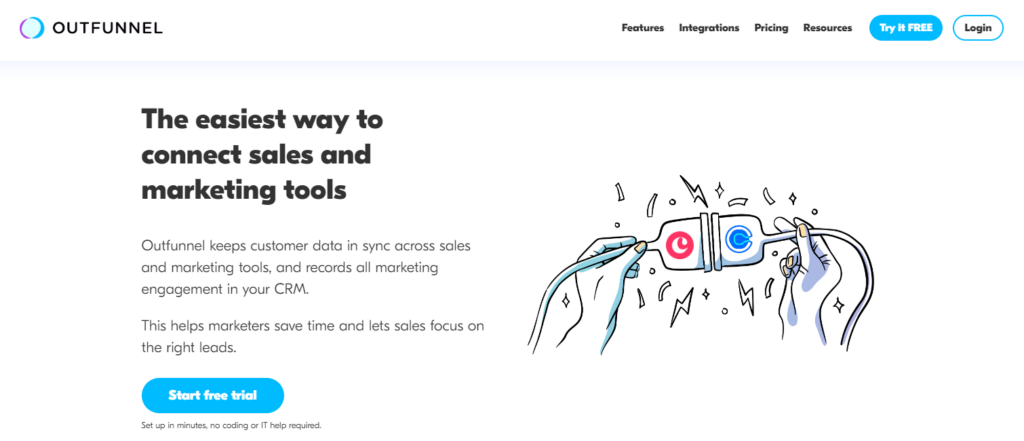
Finally, rounding out my list of the top Zapier alternatives is Outfunnel, a task automation tool designed specifically for marketing and sales.
Outfunnel Features
Outfunnel is an awesome integration tool for small to medium-sized businesses looking for ways that their marketing and sales teams can integrate, share data across multiple apps, and work together more productively.
Some of Outfunnel’s best features include:
- The ability to have your sales and marketing contact lists in sync across all apps in real-time.
- The ability to sort and manage data from multiple sources.
- Marketing campaigns can be set up easily and run automatically, with data changes made in the CRM reflected in real time.
Best of all, despite the specialized nature of its focus and the sophistication of its toolset, Outfunnel remains a relatively user-friendly option – even for the less tech-savvy user.
Outfunnel Pricing
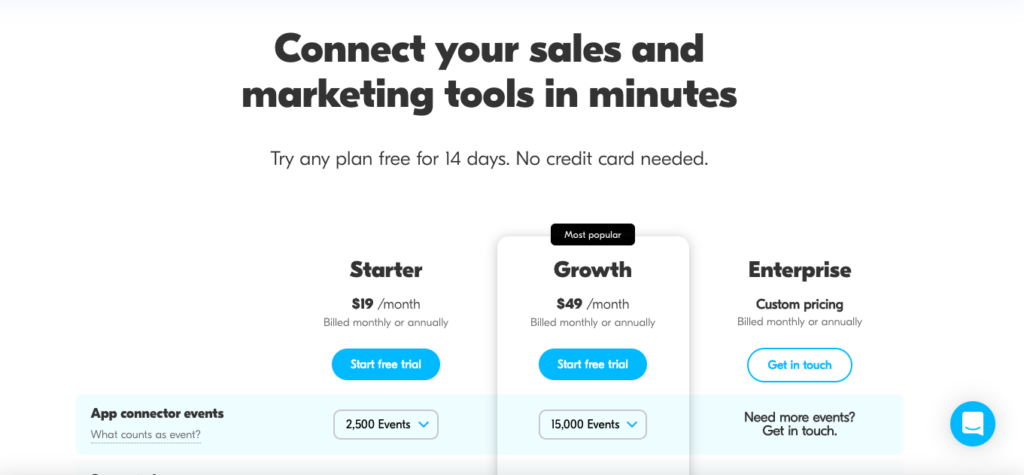
Outfunnel offers three simple plans: Starter, Growth, and Enterprise.
- Starter ($19/month): Comes with 2,500 events, all supported app integrations, 5 app connections, salesforce support, web tracking, lead scoring, and customer support via chat and email.
- Growth ($49/month): Comes with all Starter features plus 15,000 events,
- Enterprise (custom pricing): Comes with all features, plus a flexible number of events based on your needs. Contact the company directly for a customized price quote.
Zapier vs. Outfunnel?
Outfunnel is the only task automation software on my list that’s designed specifically for sales and marketing integration, making it a highly specialized and unique toolset.
As such, Outfunnel is the obvious best choice for small- to mid-sized marketing and sales teams.
On the other hand, many of Outfunnel’s features will be unnecessary for users with other purposes in mind, making Zapier the broader and more generalized fit across the board.
10. Automate.io
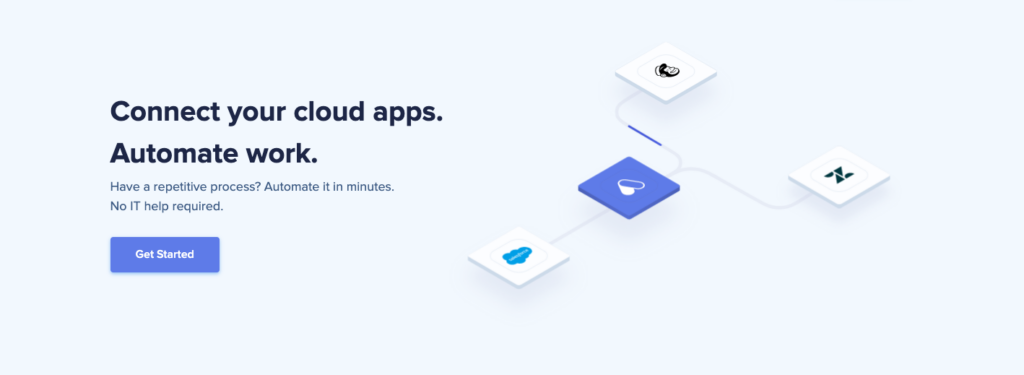
Automate.io was closed down on October 31, 2022, and was integrated with notion.so
In the fast-changing world of integration software, Automate.io stands out for its generous range of plans at prices that won’t break the bank.
Automate.io Features
Automate refers to its workflow automations as “bots,” which can be either a single-app integration or a more complex, multi-app workflow. Some of the many reasons to love Automate.io include:
- Automate.io lets you create up to 100,000 bots (automate up to 100,000 workflows) per month.
- They offer very reasonably-priced plans designed for the needs of small businesses.
- Their dashboard is intuitive and easy to learn and comes with pre-built workflows that you can test out to get a feel for how to use their workflow builder before creating your own workflows.
All in all, Automate.io is a robust and budget-friendly way to automate those tedious tasks and save yourself hours of time.
Automate.io Pricing
Automate.io gives customers an impressive range of plans to choose from, all of which come at budget-friendly prices.
- Free ($0): Automate.io’s forever free plan comes with 300 actions per month, 5 bots, a 5-minute data check, 1 team member, and single action bots.
- Personal ($9.99/month): Comes with 600 actions, 10 bots, multi-action bots, and 1 premium app.
- Professional ($29.99/month): Comes with 2,000 actions, 20 bots, and access to all premium apps.
Startup ($49/month): Includes 10,000 actions, 50 bots, 2-minute data check, and auto retry. - Growth ($99/month): Best for small teams, this plan comes with 30,000 actions, 100 bots, 3 team members, excess actions, and shared folders.
- Business ($199/month): Built for larger teams. Gives you 100,000 actions, 200 bots, a 1-minute data check, 10 team members, and data controls.
In addition to the forever free plan, Automate.io allows you to cancel any of their plans after a month for a full refund in most (but not all) cases – you’ll have to get in touch with a customer service representative to exercise this option.
Zapier vs. Automate.io?
All in all, Automate.io offers an easy-to-use set of task automation tools at an undeniably great price point.
If you’re looking to start saving time by automating your mundane tasks without breaking the bank, Automate.io may be the right choice for you.
That said, it must be mentioned that Automate.io offers noticeably fewer app integrations (only 200, compared to Zapier’s 5,000+).
So if you’re considering Automate.io as a Zapier alternative, just make sure that all of your apps are included in Automate.io’s integration list – the company is adding new integrations every month.
What is Zapier?

Zapier is an online automation tool that connects your favorite apps and services together—without any coding required. With Zapier, you can easily create workflows that automate repetitive tasks between the apps you use most.
For example, say you wanted to automatically post new Instagram photos as native Twitter posts. With Zapier, you could create a workflow that would do this for you automatically—no more manually posting your photos to both Twitter and Instagram!
Zapier is simple to use and doesn’t require any coding knowledge. Just sign up for a free account, choose the apps you want to connect and set up your workflow in minutes.
Zapier plans start with a forever-free plan that includes “components of automation” for individuals and teams alike. With the free plan, you can link any two applications together to automate tasks like data updates, email or contact creation, or alert systems.
There are four paid plans that start at $19.99/month and go all the way up to $799/month.
Questions & Answers
Our Verdict ⭐
Who likes wasting time? The answer is pretty much nobody. It’s an annoying reality that running a business – particularly an online or web business – comes with many tedious, repetitive tasks that must be completed across multiple platforms and apps.
Fortunately, there is a whole market of automation software that lets you seamlessly integrate all of your apps and platforms and automatically repeat tasks across them.
All in all, it’s safe to say that Zapier is one of the best task automation software solutions on the market. However, that’s not to say that it’s the best option for all clients or scenarios.
As you can see, if you’re looking for an alternative to Zapier, you have plenty of options.
Pabbly Connect is the leading alternative.
Connect all your favorite apps, apis, and integrations within minutes, 🚀 automate your tasks, and say goodbye to manual work!
- One-off Lifetime Plan from $249
- 1000+ Integrations Available
- No Technical Skills Required
- Beautifully Designed Workflow Builder
- Advanced Multi-Step workflows
- Secure and Reliable Infrastructure/Technology
- Trusted by 15k+ Businesses
I’ve compiled a quick review of the best 10 alternatives to Zapier, but it’s worth taking the time to dive into the research yourself and see which of these tools will be best at doing for you what they’re designed to do: saving you time so you can get back to focusing on the important things in life.
References:

